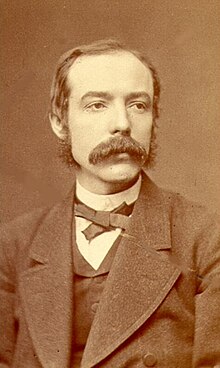Georg Hermann Quincke
Georg Hermann Quincke | |
|---|---|
 Quincke, c. 1860 | |
| Born | 19 November 1834 |
| Died | 13 January 1924 (aged 89) |
| Nationality | German |
| Known for | Streaming current Quincke's interference tube |
| Awards | ForMemRS (1879) |
| Scientific career | |
| Fields | Physics |
| Thesis | De constantibus mercurii capillaribus (1858) |
| Doctoral advisor | H. G. Magnus, F. E. Neumann |
| Doctoral students | K. F. Braun, P. Lenard |
| Other notable students | Albert A. Michelson[1] |
Georg Hermann Quincke FRSFor HFRSE (German: [ˈkvɪŋkə]; November 19, 1834 – January 13, 1924) was a German physicist.
Biography
[edit]Born in Frankfurt-on-Oder, Quincke was the son of prominent physician Geheimer Medicinal-Rath Hermann Quincke and the elder brother of physician Heinrich Quincke.
Quincke received his Ph.D. in 1858 at Berlin, having previously studied also at Königsberg and at Heidelberg. He became privatdocent at Berlin in 1859, professor at Berlin in 1865, professor at Würzburg in 1872, and in 1875 was called to be professor of physics at Heidelberg, where he remained until his retirement in 1907. His doctor's dissertation was on the subject of the capillary constant of mercury, and his investigations of all capillary phenomena are classical.
In September 1860, Quincke was one of the participants in the Karlsruhe Congress, the first international conference of chemistry worldwide. He and Adolf von Baeyer represented the University of Berlin in Congress.
Quincke also did important work in the experimental study of the reflection of light, especially from metallic surfaces, and carried on prolonged researches on the subject of the influence of electric forces upon the constants of different forms of matter, modifying the dissociation hypothesis of Clausius.
Quincke's Interference Tube is an apparatus that Quincke built in 1866 which demonstrates destructive interference of sound waves. It is also known as the Herschel-Quincke Tube; John Herschel had proposed a similar apparatus, but did not build it. The principles of the apparatus are now applied in mufflers and other noise management devices.[2][3][4]
Quincke received a DCL from Oxford and an LL.D. from Cambridge and from Glasgow and was elected an honorary fellow of the Royal Society of London. In 1885 he published Geschichte des physikalischen Instituts der Universität Heidelberg.
Quincke died in Heidelberg at the age of 89 years. He is believed to be the last living participant of the Karlsruhe Congress.
Notes
[edit]- ^ Loyd S. Swenson Jr., The Ethereal Aether, University of Texas Press, 2013.
- ^ Killy, Walter; Vierhaus, Rudolf, eds. (2011). "Quincke, Georg Hermann". Dictionary of German Biography:Platt-Schmidser. Vol. 8. Walter de Gruyter. p. 109. ISBN 9783110966305.
- ^ Beyer, Robert Thomas (1999). Sounds of Our Times: 200 Years of Acoustics. American Institute of Physics Press. p. 135. ISBN 9780387984353. OCLC 924543401.
- ^ Quincke's Interference Tube Physics; University of Michigan
See also
[edit]References
[edit]- Georg Hermann Quincke at the Mathematics Genealogy Project
 This article incorporates text from a publication now in the public domain: "Quincke, Georg Hermann". New International Encyclopedia. 1905.
This article incorporates text from a publication now in the public domain: "Quincke, Georg Hermann". New International Encyclopedia. 1905.
- 1834 births
- 1924 deaths
- 19th-century German physicists
- People from Frankfurt (Oder)
- Scientists from the Province of Brandenburg
- Physicists from the Kingdom of Prussia
- University of Königsberg alumni
- Heidelberg University alumni
- Academic staff of Heidelberg University
- Humboldt University of Berlin alumni
- Academic staff of the Humboldt University of Berlin
- Academic staff of the University of Würzburg
- Foreign members of the Royal Society
- Members of the Göttingen Academy of Sciences and Humanities
- Recipients of the Cothenius Medal
- German academic biography stubs
